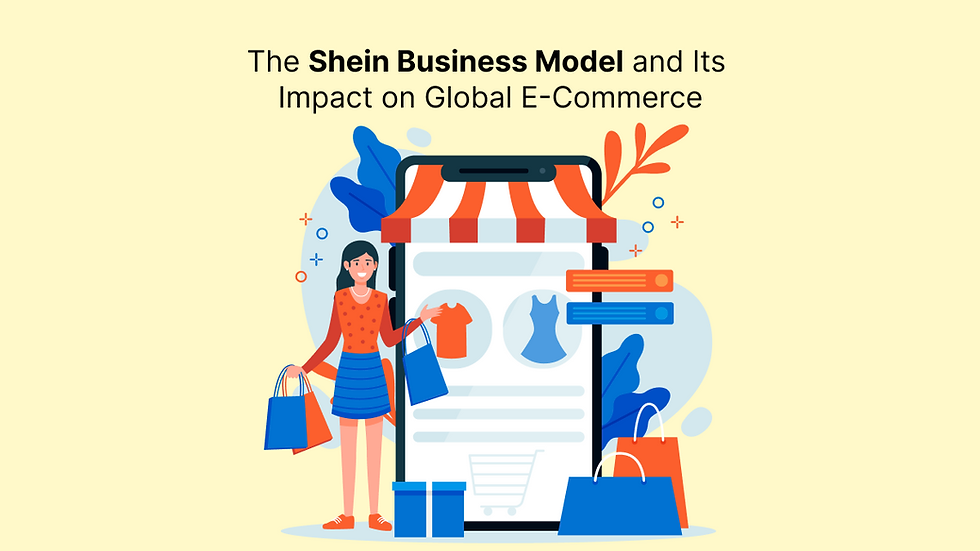The Shein Business Model and Its Impact on Global E-Commerce
- Harry Clark

- Aug 25
- 5 min read

Shein has become a household name in fashion e-commerce. The company started as a small online clothing retailer but quickly grew into one of the biggest fast-fashion platforms in the world. Known for its low-cost clothing, trendy designs, and quick response to consumer demand, Shein has disrupted the traditional fashion industry while setting new standards for online retail. For entrepreneurs and startups, understanding the Shein business model can give valuable lessons about how global e-commerce is changing.
The Growth Journey of Shein
Shein was founded in China in 2008 and focused primarily on affordable women’s fashion. Unlike traditional fashion brands that depend on seasonal collections and physical outlets, Shein embraced digital-first strategies. The brand’s rise was fueled by the use of data, a flexible supply chain, and heavy reliance on online platforms. It did not take long for Shein to expand beyond China and reach markets across Europe, the United States, and Asia. Today, Shein is one of the most downloaded shopping apps in the world.
How the Shein Business Model Works
Fast Fashion Reinvented
Fast fashion is not new, but Shein took it to a completely different level. While other brands like Zara and H&M may take weeks to launch new products, Shein often takes just a few days. The company produces clothing in small batches and tests it in the market. If a product sells well, production is increased. If it fails, they stop making it. This fast cycle allows Shein to stay on top of fashion trends and respond to consumer demand in real time.
Data as the Core Driver
Data is at the heart of Shein’s business. The company collects massive amounts of information from its website, app, and social media channels. By analyzing what customers are searching for, buying, or even browsing, Shein knows which designs will be successful. This reduces the risk of wasted production and ensures that most of its products find buyers quickly.
Supply Chain Efficiency
Another major factor behind Shein’s success is its supply chain. Shein partners with thousands of manufacturers who are able to produce clothing quickly and at low cost. Its supply chain is flexible, meaning it can scale production up or down depending on customer demand. This system reduces excess inventory, one of the biggest challenges in traditional retail.
Online-First Approach
Unlike older fashion companies, Shein never relied on physical stores. It built its empire entirely online. With a strong presence on its app and website, as well as massive campaigns on TikTok, Instagram, and YouTube, Shein connects directly with its target audience. Its marketing strategies often involve influencers, which helps the brand maintain popularity among young consumers worldwide.
The Global Impact of Shein
Shaping Consumer Behavior
Shein has changed how consumers think about shopping. Customers now expect fast delivery, trendy products, and affordable prices. Many people buy from Shein not just for clothing but also for accessories, shoes, and even home products. This shift has influenced other e-commerce platforms to rethink their models to match consumer expectations.
Challenging Traditional Retail
Shein’s growth has posed a major challenge for traditional retailers. Brands that rely on physical outlets and slower production cycles struggle to compete with Shein’s speed and pricing. This has forced many companies to invest more in e-commerce and adopt faster supply chain strategies.
Expanding Global E-Commerce
Shein’s success also highlights how e-commerce has broken geographic barriers. A brand from China now dominates fashion markets in the US and Europe without having physical stores. This shows that startups with the right strategy can enter international markets without needing traditional infrastructure.
Raising Concerns on Sustainability
One of the criticisms of Shein is its role in promoting fast fashion, which has been linked to environmental concerns. The brand’s model encourages frequent purchases and quick disposal of clothes, raising questions about sustainability. This debate has sparked conversations in global e-commerce about balancing growth with responsibility.
Lessons Startups Can Learn from Shein
The Power of Speed
Shein proves that speed can be a powerful competitive advantage. For startups, being able to adapt quickly to customer needs and market trends can make the difference between success and failure.
Data is Key
By using data effectively, businesses can reduce risks and improve customer satisfaction. Startups in any industry should learn how to collect, analyze, and use data to guide decisions.
Flexibility in Operations
Shein’s flexible supply chain shows the value of adaptability. Startups should design their operations in a way that allows them to scale up or down depending on demand.
Building Strong Digital Presence
Shein’s digital-first approach is a reminder that in today’s world, having a strong online presence is crucial. Startups should invest in websites, apps, and digital marketing to connect with customers globally.
The Future of Global E-Commerce with Models Like Shein
The success of Shein signals a new era in global e-commerce where speed, affordability, and digital marketing dominate. More companies will likely follow similar models to stay competitive. At the same time, consumers are becoming more aware of sustainability, meaning future businesses may need to combine Shein’s efficiency with more eco-friendly practices. Startups that can strike this balance will have the best chance of long-term success.
Conclusion
The Shein business model has had a huge impact on global e-commerce by showing how speed, data, and online-first strategies can drive massive growth. It has reshaped consumer expectations and challenged traditional retailers, while also raising important discussions about sustainability. For startups, the key lessons lie in staying adaptable, using data wisely, and focusing on building a strong digital presence. To turn these ideas into real ventures, working with a reliable clone app development company can help entrepreneurs bring innovative and scalable solutions to life, much like the opportunities offered by a gojek clone app.

FAQs
What is unique about Shein’s business model?
Shein’s business model is unique because it combines fast production, data-driven decisions, and an online-first strategy, allowing it to stay ahead of trends and reach global audiences.
How does Shein use data in its business?
Shein collects data from its app, website, and social media to understand what customers want. This helps it launch products with higher chances of success.
What impact has Shein had on global e-commerce?
Shein has changed consumer expectations by making affordable and trendy products available quickly. It has also influenced other brands to move faster and invest in digital platforms.
Can startups replicate Shein’s model?
Startups can learn from Shein by being adaptable, using data to guide decisions, and focusing on building a strong online presence, though they may need to scale differently.
What challenges does Shein face?
Shein faces challenges like sustainability concerns, heavy competition, and the need to maintain customer trust while scaling its operations globally.




Comments